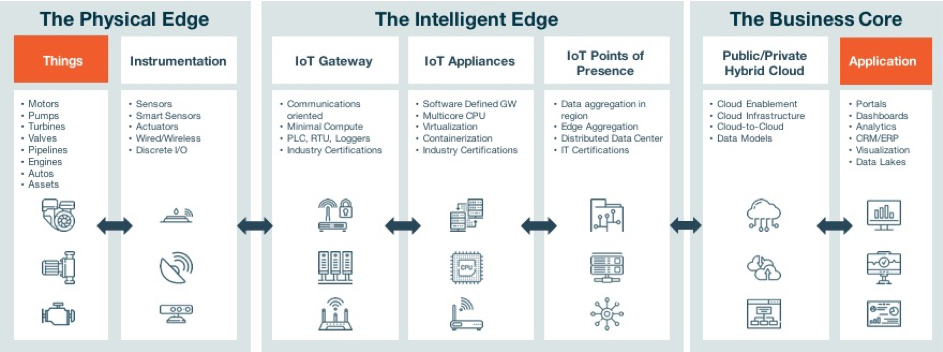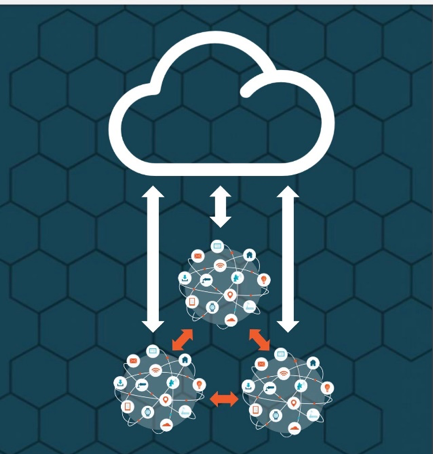DOWNLOAD
The Intelligent Edge: Opportunity and IoT Innovation
Ed Maguire

We wrote The Intelligent Edge: Opportunity and IoT Innovation to address the growing interest and curiosity around Edge computing. The concepts around Edge computing are not new but are increasingly relevant as IoT-connected systems scale and become increasingly autonomous. Interest in and demand for more powerful real-time data analytics is fueling an interest in an evolving architectural paradigm that harnesses the advantages of powerful centralized data centers with the nimbleness and flexibility of devices positioned at the physical edge.
Technological and business needs are driving interest in Edge computing. With often overwhelming volumes and velocity of sensor and endpoint data, it’s neither cost effective nor practical to rely on centralized data centers for processing and analysis. Edge computing enables raw data to be filtered and aggregated as it’s generated, with only the most important data sent to the data center for deeper analysis. This approach reduces the costs of data ingestion and network latency.
When there’s need for real time responses to sensor data, edge computing enables data to be analyzed and acted on in near-real time. Edge computing is poised to enable a powerful new generation of flexible and distributed analytics for Connected Industry, ultimately powering a broad range of autonomous and self-optimizing systems.
High growth opportunities will come from the edge
There is promising growth forecast for edge computing adoption. IDC estimates that by 2019, 40% of IoT Data will be processed at the edge, while the overall market for IoT infrastructure is forecast to grow at a 10.5% CAGR to $16 billion in 2021. Edge infrastructure is forecast to grow at a 22.0% CAGR to $3.4 billion in 2021. Growth in computing will primarily come from edge gateways and converged IT/OT systems.
There are limitations to relying solely on a centralized cloud-based approach for IoT:
- Data latency: In time sensitive use cases which require real time data analytics where a split-second delay of data going to the cloud and back to the device could be disastrous or deadly, analytics needs to be embedded into operational processes.
- Locational challenges: Localized processing needs to take place in diverse environments - hardware needs to be rugged to survive diverse environments including hard to reach locations, ‘canary in mine’ spaces and those exposed to harsh weather.
- Customers don’t want siloed systems or services: In many industrial workplaces, the environment may be a digital divide: a cornucopia of unconnected legacy machines, non-compatible devices and controllers. Information exists in siloed systems and there’s a physical in-house divide between IT and OT.
Defining The Edge
Edge computing is a broad term that straddles several broad categories, and definitions can be fluid. The IoT data flow begins with front-end sensor data and ends with systems using analytics and decision-making capability driving intelligent actions. We look at edge computing technologies along a continuum:

The Physical Edge: This can also be referred to as the “hard” edge, the Physical Edge includes connected “things” as well as devices, sensors, actuators and other machines and devices that generate data from processes, instrument readings and other sources.
The Intelligent Edge: This comprises what most people think of when they hear the term “Edge Computing”. In our definition, the Intelligent Edge encompasses three variants of increasing size and scope.
- IoT Gateways are simple edge devices, focused on communications functions with minimal compute capabilities.
- IoT Appliances are far more robust, multi-core, often running virtualized or containerized applications, sometimes carrying certifications for specific industry use cases.
- IoT Points of Presence are super–aggregation points for other intelligent gateways, also referred to as Distributed or Edge Data Centers or Data Center at the Edge.
The Business Core: This comprises the core of the enterprise compute infrastructure, whether it reside in a public, private or hybrid cloud.
A few advantages deploying edge-based devices include:
- Speed – Edge computing reduces latency because data doesn’t have to travel over a network to a remote data center or the cloud for processing.
- Network independence and its locational benefits – Edge computing enables the ability to operate independently of the network availability or cost, reduce data transfer rates, and control what data stays on-site versus what is delivered to the cloud.
- Scalability and cost reduction – Edge computing is fundamentally ‘distributed computing,’ meaning it improves resiliency and reduces network load, and can be more efficient overall when processing data at the point of origin. These characteristics all lower overall cost.
Beyond Cloud and Fog to “Edge Hives“
While it may be tempting to champion edge and fog computing as the panacea of all the pain points of cloud computing, the reality is that we are going to see more of an aggregate model, encompassing the isolation of the edge with the power of selective aggregation of data and “nodes” at the edge.
We refer to these models as “Edge Hives”- aggregations of processes that can operate autonomously and also can share/learn with other hives and clouds. These can be physical or logical aggregations, with software containers selectively and dynamically aggregated into hives. The hives can provide a model around which one can build out solutions at the edge so that there’s a succession and each logical “hive” can have a different set of roles. The hive approach would allow us to dynamically repurpose or adapt the capabilities of the edge nodes as well.

Many businesses require historical analysis for process improvement and model development. This is best done when the data from multiple edge devices can be combined centrally to provide the relevant holistic view. Moreover, insights gained from historical analysis can be pushed back to the edge, so that an IoT-enabled edge device continually evolves to make better real-time decisions. The compute model becomes a combination of edge and cloud computing where IoT devices operate at the edge in real time, collect and process raw data at the edge, and share metadata to the cloud for comprehensive historical analysis and continuous process improvement.
Drowning in hype cycles and statistics about IoT, blockchain and Connected Industry? Momenta Partners takes a fresh look at the challenges confronting industry through a series of thought pieces: podcasts, webinars, blog posts and whitepapers. Learn how our industry insights can help grow your business.




